Post by Scrit on Dec 27, 2007 15:59:40 GMT
Well, here's the second installment of the quiz in which I hope to bamboozle, mystify and possibly inform...... (actually fat chance with the brains trust here, but one can but hope ;D). As before correctly answered questions will be in black with answers in green whilst unanswered questions will be in red. There are another 20 questions here, so hopefully something for everyone ;D
All questions now answered
26. What was the length of the longest (length) production woodworking plane ever made by Stanley and how long was it?
A Stanley #34 transitional jointer at 30in length was the longest woodworking plane ever listed in the Stanley catalogue -- First correct answer by andee
27. Name this joint? Where is it used?
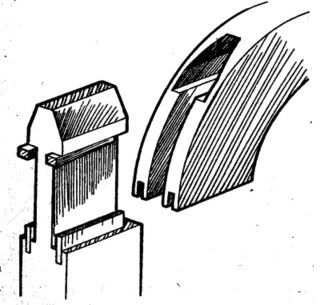
The hammer head joint. This was at one time used to join the top members of round headed doors and/or frames to the upright stiles (I've seen it on both). The wedges draw the joint together tightly whilst the tongues prevent the wood from being forced outwards at the shoulders. Sometimes the hammer head is made in the form of a double-ended loose key -- First correct answer by opener
28. Which pest is this?


It is the common furniture beetle (anobium punctatum). The most common of all wood-boring beetles in the UK, being most prevalent in the south and east of the country -- First correct answer by JFC
29. What does this machine do? Please state it's precise purpose!
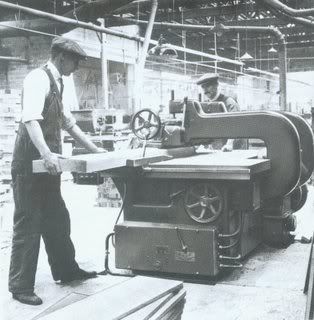
This is a straight line edger, in this case a Wadkin PU made from the 1930s to the 1970s and used to rip off the waney edges on hardwoods in particular prior to futhre processing such as passing through a 4-sided moulder. A multi-blade version for lath ripping appeared at much the same time -- First correct answer by SgianDubh
30. Who invented the portable electric plunge router, and when?
The plunge router was invented by Carter in 1928 who then sold out to Stanley in 1934-35
There has been a half answer in that Elu (Eugen Lutz) was certainly the first firm to manufacture a portable plunge router (the MOF11 was the model) in Europe, although they didn't invent it. The year was 1949 although the patent application was granted more than 20 years before that -- Half correct answer by PaulChapman......... Still looking for the definitive answer
31. What function does a muntin fulfill in a drawer bottom?
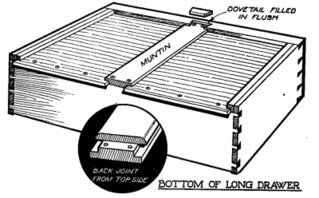
It divides the bottom into smaller pieces and strengthens the drawer. It's use means that thinner and lighter materials can be used to construct even quite large drawers -- First correct answer by Scrums
32. I need to divide a line into 7 equal segments using only a straight edge, dividers, pencil and set square (NO ruler). How do I do this? I know this isn’t a woodworking question per se, but it is nonetheless a necessity for setting-out such as spacing dovetails

With the exception that the set square is slid along a straight edge rather than a line the correct answer is as follows:
Say the line we want to divide has ends A and B.
1. Use the straight edge to draw a straight line from end A, at an angle to AB
2. Use dividers to step off 7 equal increments along this line.
3. Use set square to draw a straight line from the last increment to end B.
4. Without moving set square, position the straight edge against one face of the set square to allow it to slide
5. Slide set square along straight edge so that you can project lines parallel to the first down to line AB giving you 7 equal spacings.
A worked example is shown above. This sort of setting out has its uses from setting out dovetail spacing to roofing -- First correct answer by Dave S
33. What type of saw is this?

It is a rip saw. Whay didn't you get that Jason? -- First correct answer by Evergreen
The original image was this one:

34. One for the joiners. In which joint might you find a frank, and what is it?
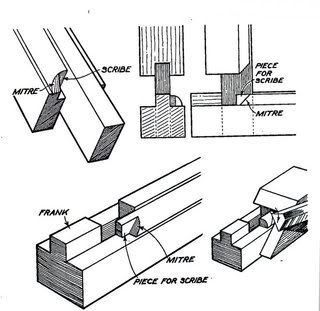
The correct answer was given by SgianDubh who then came back and complained that I was picky! Moi? I was after an example and I have to admit the only place I've ever seen these is in joiner's combined mitre and scribed joints as applied to window frames (see drawing above) -- First correct answer by Sgian Dubh
I was after an example and I have to admit the only place I've ever seen these is in joiner's combined mitre and scribed joints as applied to window frames (see drawing above) -- First correct answer by Sgian Dubh
35. How do you check a square for being true (without using any other instrument)?
Use the square to draw a line at 90 degrees to a true edge. Then flip the square over and draw another line on top of the first one. They should coincide exactly. Try this in B&Q and you'll see just what sort of crap they sell! Incidentally you'll sometimes find that this only works on either the inside or outside edge of the blade because many blades have edges which are not completely parallel. Try it and see -- First correct answer by Scrums
36. What is the full name of this jig or tool and what is it's use?
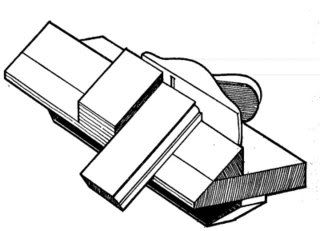
A "donkey's ear" shooting board used for shooting mitres -- First correct answer by PaulChapman
37. Who invented the circular saw? And when?
The circular saw was probably invented by William Walter Taylor. The first recorded use of a circular saw in England appears to be in the woodworking shop of William Walter Taylor (1734 - 1803), a Southampton carpenter and manufacturer of ship's sheave blocks, who in 1781 had a saw in use. According to the Hampshire Repository of 1801 his circular saw "proved of ineffible use in expediously cutting timber for any purpose". Our American cousins tend to quote Tabitha Babbit (1813), although that particular claim is erroneous as circular saws were in use in the Royal Navy's Portsmouth Block-Making Department which was installed by Marc Brunel (Isambard Kingdom's father) between 1803 and 1805 this installation pre-dating the good Sister's work by some 8 to 10 years. Not sure about the 1760 reference Dom, where did that come from? -- First correct answer by Dom
38. Which pest is this?
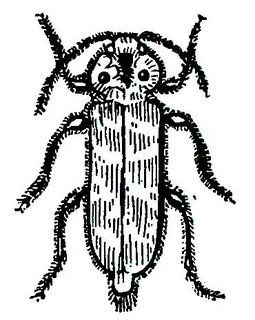

The house longhorn beetle (hylotrupes bajulus). Whilst uncommon in the UK this pest has become more prevalant since WWII, although it is mainly confined to parts of Surrey and Hampshire, where the coniferous heathland and warm summers seem to suit its development -- First correct answer by JFC
39. This timber, of which Merlin's staff was reputedly made, was once favoured in such situations as bearing blocks and pulley sheaves. What is its' name?
Lignum vitae -- First correct answer by Scrums (who I'm beginning to suspect of being a Jedi)
40. In spindle moulding work what is the main reason for having a tilting arbor?
The main reason for a tilting arbour was that if you have a large block with say 9" projecting at the top and 6" at the bottom the top and bottom will be rotating at unequal speeds, so tilting it would equalise the speed and equilibrium.
Should you wish to research this further, suggest you read:
Spindle Moulder by Eric Stephenson
41. Name the following modern man-made woodworking materials: MFC, MR-MDF, HDF, RF, MF-MDF and HPL
MFC = Melamine faced chipboard
MR-MDF = Moisture resistant medium density fibreboard (green blotting paper)
HDF = High density fibreboard (dense blotting paper)
RF = Resorcinol formaldehyde (glue used in plywood and lamination manufacture)
MF-MDF = Melamine faced medium density fibreboard (melamine-faced blotting paper)
HPL = High pressure laminate (often used for toilet cubicle walls)
-- Almost all the answers correct by 9Fingers, but what about RF? Well that one was gotten by andy king
42. Name 5 forms of commonly-used woodworkers cramps other than G-cramps or C-cramps
Fretwork, holdfast, mitre, sash and web (Chapman again!) although I also had F-cramps, spring cramps, cam cramp, hand screws and guitar cramps. Anyone know any more? -- First correct answer by PaulChapman
43. From what was casein glue made?
Casein comes from milk - so casein glue starts out as milk. It's actually stronger than PVA. There's a small article on it and how to make it here -- First correct answer by Scrums
44. When making a dovetailed box with a removeable lid how does one normally ensure that the top and bottom will line up correctly in both grain direction and pattern?
Make the box as a closed cube, then saw the lid off (making one of the dovetails larger to allow for the saw cut) -- First correct answer by PaulChapman
45. Which British planemaker was based in the town of Ayr?
Stuart Spiers was indeed based in Ayr -- First correct answer by PaulChapman
Enjoy!
Scrit
All questions now answered
26. What was the length of the longest (length) production woodworking plane ever made by Stanley and how long was it?
A Stanley #34 transitional jointer at 30in length was the longest woodworking plane ever listed in the Stanley catalogue -- First correct answer by andee
27. Name this joint? Where is it used?

The hammer head joint. This was at one time used to join the top members of round headed doors and/or frames to the upright stiles (I've seen it on both). The wedges draw the joint together tightly whilst the tongues prevent the wood from being forced outwards at the shoulders. Sometimes the hammer head is made in the form of a double-ended loose key -- First correct answer by opener
28. Which pest is this?


It is the common furniture beetle (anobium punctatum). The most common of all wood-boring beetles in the UK, being most prevalent in the south and east of the country -- First correct answer by JFC
29. What does this machine do? Please state it's precise purpose!

This is a straight line edger, in this case a Wadkin PU made from the 1930s to the 1970s and used to rip off the waney edges on hardwoods in particular prior to futhre processing such as passing through a 4-sided moulder. A multi-blade version for lath ripping appeared at much the same time -- First correct answer by SgianDubh
30. Who invented the portable electric plunge router, and when?
The plunge router was invented by Carter in 1928 who then sold out to Stanley in 1934-35
There has been a half answer in that Elu (Eugen Lutz) was certainly the first firm to manufacture a portable plunge router (the MOF11 was the model) in Europe, although they didn't invent it. The year was 1949 although the patent application was granted more than 20 years before that -- Half correct answer by PaulChapman......... Still looking for the definitive answer
31. What function does a muntin fulfill in a drawer bottom?

It divides the bottom into smaller pieces and strengthens the drawer. It's use means that thinner and lighter materials can be used to construct even quite large drawers -- First correct answer by Scrums
32. I need to divide a line into 7 equal segments using only a straight edge, dividers, pencil and set square (NO ruler). How do I do this? I know this isn’t a woodworking question per se, but it is nonetheless a necessity for setting-out such as spacing dovetails

With the exception that the set square is slid along a straight edge rather than a line the correct answer is as follows:
Say the line we want to divide has ends A and B.
1. Use the straight edge to draw a straight line from end A, at an angle to AB
2. Use dividers to step off 7 equal increments along this line.
3. Use set square to draw a straight line from the last increment to end B.
4. Without moving set square, position the straight edge against one face of the set square to allow it to slide
5. Slide set square along straight edge so that you can project lines parallel to the first down to line AB giving you 7 equal spacings.
A worked example is shown above. This sort of setting out has its uses from setting out dovetail spacing to roofing -- First correct answer by Dave S
33. What type of saw is this?

It is a rip saw. Whay didn't you get that Jason? -- First correct answer by Evergreen
The original image was this one:

34. One for the joiners. In which joint might you find a frank, and what is it?

The correct answer was given by SgianDubh who then came back and complained that I was picky! Moi?
 I was after an example and I have to admit the only place I've ever seen these is in joiner's combined mitre and scribed joints as applied to window frames (see drawing above) -- First correct answer by Sgian Dubh
I was after an example and I have to admit the only place I've ever seen these is in joiner's combined mitre and scribed joints as applied to window frames (see drawing above) -- First correct answer by Sgian Dubh35. How do you check a square for being true (without using any other instrument)?
Use the square to draw a line at 90 degrees to a true edge. Then flip the square over and draw another line on top of the first one. They should coincide exactly. Try this in B&Q and you'll see just what sort of crap they sell! Incidentally you'll sometimes find that this only works on either the inside or outside edge of the blade because many blades have edges which are not completely parallel. Try it and see -- First correct answer by Scrums
36. What is the full name of this jig or tool and what is it's use?

A "donkey's ear" shooting board used for shooting mitres -- First correct answer by PaulChapman
37. Who invented the circular saw? And when?
The circular saw was probably invented by William Walter Taylor. The first recorded use of a circular saw in England appears to be in the woodworking shop of William Walter Taylor (1734 - 1803), a Southampton carpenter and manufacturer of ship's sheave blocks, who in 1781 had a saw in use. According to the Hampshire Repository of 1801 his circular saw "proved of ineffible use in expediously cutting timber for any purpose". Our American cousins tend to quote Tabitha Babbit (1813), although that particular claim is erroneous as circular saws were in use in the Royal Navy's Portsmouth Block-Making Department which was installed by Marc Brunel (Isambard Kingdom's father) between 1803 and 1805 this installation pre-dating the good Sister's work by some 8 to 10 years. Not sure about the 1760 reference Dom, where did that come from? -- First correct answer by Dom
38. Which pest is this?


The house longhorn beetle (hylotrupes bajulus). Whilst uncommon in the UK this pest has become more prevalant since WWII, although it is mainly confined to parts of Surrey and Hampshire, where the coniferous heathland and warm summers seem to suit its development -- First correct answer by JFC
39. This timber, of which Merlin's staff was reputedly made, was once favoured in such situations as bearing blocks and pulley sheaves. What is its' name?
Lignum vitae -- First correct answer by Scrums (who I'm beginning to suspect of being a Jedi)
40. In spindle moulding work what is the main reason for having a tilting arbor?
The main reason for a tilting arbour was that if you have a large block with say 9" projecting at the top and 6" at the bottom the top and bottom will be rotating at unequal speeds, so tilting it would equalise the speed and equilibrium.
Should you wish to research this further, suggest you read:
Spindle Moulder by Eric Stephenson
41. Name the following modern man-made woodworking materials: MFC, MR-MDF, HDF, RF, MF-MDF and HPL
MFC = Melamine faced chipboard
MR-MDF = Moisture resistant medium density fibreboard (green blotting paper)
HDF = High density fibreboard (dense blotting paper)
RF = Resorcinol formaldehyde (glue used in plywood and lamination manufacture)
MF-MDF = Melamine faced medium density fibreboard (melamine-faced blotting paper)
HPL = High pressure laminate (often used for toilet cubicle walls)
-- Almost all the answers correct by 9Fingers, but what about RF? Well that one was gotten by andy king
42. Name 5 forms of commonly-used woodworkers cramps other than G-cramps or C-cramps
Fretwork, holdfast, mitre, sash and web (Chapman again!) although I also had F-cramps, spring cramps, cam cramp, hand screws and guitar cramps. Anyone know any more? -- First correct answer by PaulChapman
43. From what was casein glue made?
Casein comes from milk - so casein glue starts out as milk. It's actually stronger than PVA. There's a small article on it and how to make it here -- First correct answer by Scrums
44. When making a dovetailed box with a removeable lid how does one normally ensure that the top and bottom will line up correctly in both grain direction and pattern?
Make the box as a closed cube, then saw the lid off (making one of the dovetails larger to allow for the saw cut) -- First correct answer by PaulChapman
45. Which British planemaker was based in the town of Ayr?
Stuart Spiers was indeed based in Ayr -- First correct answer by PaulChapman
Enjoy!
Scrit




 Not sure when though.
Not sure when though.
 )
)

